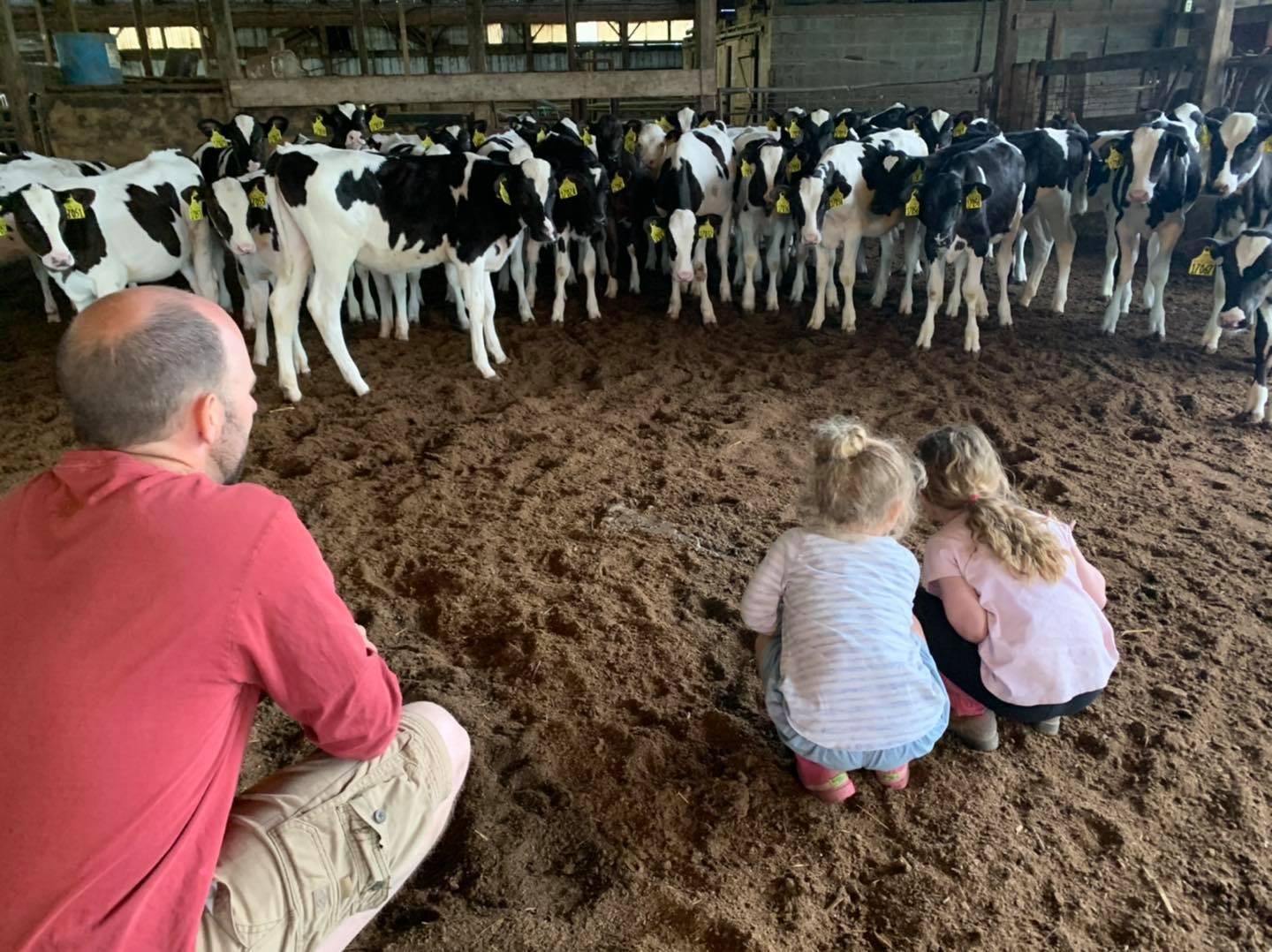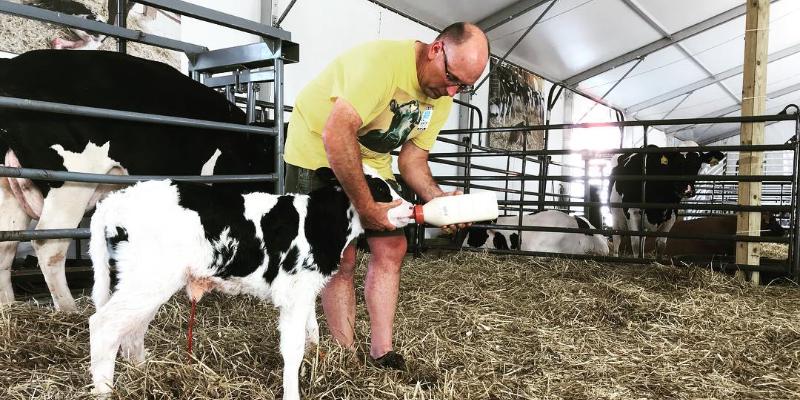-
September 11, 2020

- • Featured • Industry News
Dairy Farmers Managing Cows and Social Media to Connect with Consumers
Like fire, the wheel, automobiles and the telephone, social media has changed the world forever. Roughly one-in-three people across the globe are using social media platforms today to share, inform, influence, promote, and make friends. As a minority population in the US – weighing in at less than two percent – farmers and ranchers are gaining online proficiency and sophistication using Facebook, Instagram, and others to connect directly with consumers. At 4,000 strong, NY dairy farmers are no exception.
People are Curious
 Twins Claire and Emilie Mulligan manage social media for Mulligan Farm. The Livingston County Farm is one of eight local dairies involved in Craigs Creamery of York, NY.
Twins Claire and Emilie Mulligan manage social media for Mulligan Farm. The Livingston County Farm is one of eight local dairies involved in Craigs Creamery of York, NY.
At 27-years old, Emilie Mulligan represents the fourth generation at Mulligan Farm in Avon, NY. This century farm milks 1,300 cows on 2,600 acres in the shadow of suburban Rochester. A Cornell graduate, Emilie most recently participated in the Young Dairy Leaders Institute, a nationally recognized leadership development program that prioritizes media training and consumer advocacy as important skills necessary to succeed in today's business climate.
“People are interested in what’s happening on the farm, and curious about the technology we use,” said Emilie. “And nobody can resist a baby calf.” She and her twin sister Claire are managing the farm’s social media. She involves the farm’s field crew where and when she can to show the feed to milk connection. “All farmers can do something,” said Emilie. “We all have different circles of influence considering our network of friends and family. For me it could be sorority sisters living in New York City or extended family in urban Buffalo. I don’t post on a consistent schedule, but at the very minimum, I try to do something once a week.”
 Emilie Mulligan posted this photo and farm fact on their Instagram page in 2019: Did you know that 1 acre of corn eliminates 8 tons of carbon dioxide from the air? A lot of the CO2 is held in the soil to improve water infiltration, enhance nutrient cycling and reduce compaction and runoff on fields.
Emilie Mulligan posted this photo and farm fact on their Instagram page in 2019: Did you know that 1 acre of corn eliminates 8 tons of carbon dioxide from the air? A lot of the CO2 is held in the soil to improve water infiltration, enhance nutrient cycling and reduce compaction and runoff on fields.
Emilie’s most popular post was a picture taken from the front seat of a truck during corn harvest 2019. The message addressed corn’s ability to suck up carbon from the atmosphere. “The post was shared all over the country by many farm pages as well as Cooperative Extension and 4H,” added Emilie. “It was fun to see that people appreciated it.” She has also jumped into doing virtual farm tours for diverse audiences ranging from a local preschool to food bloggers. “It takes some practice. My first two tours were just me on my phone showing kids up close and personal what’s happening on the farm. I was able to take them with me as I sat in a tractor and prepped a cow for milking, looking directly at her udder at eye level. I couldn’t do any of these things on an in-person tour!
“Random people will come up to me, that are not in agriculture, and comment on something I’ve posted,” said Emilie. “That’s exactly what I want to hear.”
Making New Connections
Kim Skellie and George Andrew are college classmates that became business partners in an established family farm located in Newark, NY. El-Vi Farms has grown from the 40 cows that Elmer and Viola Peck started with in 1953 to 2,000 cows in 2020. Working with two other partners – Allan Ruffalo and Josh Peck, Kim is the “people” guy and George is the cow man.
“The number one reason we use social media is to help the public understand how we treat animals,” said Kim. “Consumers like me are more and more interested in making a positive difference through our purchasing power. As a farm, we don’t want negative misconceptions about how we operate to deter people from buying dairy products.
 “I met a woman from Manhattan who had a lot of questions about dairy farming at the NYS Fair, and we both had ah-hah moments,” said Kim Skellie, one of four partners of El-Vi Farms of Newark, NY. “Through social media, this type of interaction is possible on a much wider basis.”
“I met a woman from Manhattan who had a lot of questions about dairy farming at the NYS Fair, and we both had ah-hah moments,” said Kim Skellie, one of four partners of El-Vi Farms of Newark, NY. “Through social media, this type of interaction is possible on a much wider basis.”
“At the NYS Fair a few years back I met a woman from Manhattan who had a lot of questions about dairy farming,” said Kim. “Talking one-on-one with her, we both had ah-hah moments. Through social media, this type of interaction is possible on a much greater scale. We’re also able to inform legislators who are increasingly involved in animal policymaking. This is their chance to gain some knowledge that will influence future decision-making.”
George has taken the farm’s social media presence to a whole new level by hosting virtual farm tours sponsored by American Dairy Association North East. Imagine having 2,000 middle schoolers from New York City following your every word and step as you walk from maternity pen to the milking parlor and points in between. Students ask questions and get immediate responses from George who is outfitted with a microphone and shadowed by a camera. “With the right technology you can do amazing things,” said George. Farm buildings have wireless connectivity, and George’s daughter Emma quarterbacks from a small office. “Students are so far removed from what we do, and never have the opportunity to put it all together. This has been fun for me. It gives me a fresh perspective on why I’m farming in the first place.
“Every farm should have a website or Facebook page to help build a positive image for farming and to create new relationships,” added George. “There is a train coming that we can’t stop, but we can be a part of the movement. El-Vi has been online for 10 years. Building trust in the communities where we live, and work is very important. To do this well, posts need to be truthful, friendly, and positive and someone within the operation needs to be responsible and trained accordingly. At the end of the day you may still have differences of opinion, but I’ve never had a bad experience.”
A Group Effort
 For farmers it’s more than a job... it’s a way of life and having the opportunity to share your passion with the next generation is a true gift!?? A sample post from Barbland & White Eagle Dairies.
For farmers it’s more than a job... it’s a way of life and having the opportunity to share your passion with the next generation is a true gift!?? A sample post from Barbland & White Eagle Dairies.
The Bossards are one of four families who operate Barbland & White Eagle Dairies in Central New York. Between three locations, the operation milks 3,300 cows and tills upwards of 8,500 acres in Onondaga, Madison, and Chenango counties. The mother of two little girls and a full-time ag teacher at Hamilton Central Schools, Johanna Bossard is what she calls the farm’s PR specialist. “Facebook was an easy transition for us, because I used it personally,” said Johanna. “But my game has gotten better over 10 years, and the farm is now on Instagram too. I have a personal passion for sharing what we do for a living and trying to correct misconceptions that consumers have about agriculture.” The farm has nearly 6,000 followers.
“I try to post four to six times a week on Facebook and three to five times weekly on Instagram,” added Johanna. “I look for topics that are relevant to the industry, tie-in to politics, or trending in the news. I try to involve our daughters ages nine and four to help tell the story too. Some posts are meant to entertain; others to educate. In general, I try to be proactive rather than reactive.” Regular posts include “Fun-Farm-Fact-Friday,” updates on crop harvests, and information on cow and calf management.
“We target the ‘moveable middle’ or that portion of the population who wants to be better informed and is looking for good information,” said Johanna. “There are some followers that will never be happy with what we do and can be extremely negative with their comments. If I know a specific message may be contentious, I want to be sure I have enough time blocked out where I can help manage the conversation. It does hurt what people can say, but we get back on the horse and continue to do what we do best.”
Teaching high school classes, advising an FFA chapter, and parenting does not give Johanna much time to spend online. “I’m not on the farm every day, so I look to our staff to help me with content,” said Johanna. “They may not feel fixing equipment, cropping or helping with a calf delivery are particularly newsworthy. But our neighbors or followers who live half-way around the world, love to see what’s happening daily on our farm. Every impression helps frame an opinion about what we do and love. If all dairy farms shared similar stories just a little bit more, it would help the entire industry.”
“This article was brought to you by the New York Animal Agriculture Coalition (NYAAC). NYAAC is a farmer founded and funded not-for-profit organization that strives to enhance the public’s understanding of and appreciation for animal agriculture and modern farm practices. NYAAC is effective in doing so by engaging the public in conversations about animal agriculture and empowering farmers to tell their story firsthand.”
For more information on the farms profiled above, go to:
